Monitoring and Evaluation of High-Speed Railway Turnout Grinding Effect Based on Field Test and Simulation
Abstract
1. Introduction
2. Investigation of Field Measurement Problems
2.1. Wheel–Rail Force Monitoring
2.2. Carbody Lateral Vibration Monitoring
2.3. Wheel and Rail Evaluation
3. Wheel–Rail Contact Geometric Characteristics Analysis
3.1. Rail Profiles before and after Grinding
3.2. Equivalent Conicity
3.3. Wheel–Rail Contact Point Distribution
4. Establishment of Vehicle–Turnout Coupled Dynamic Model
4.1. Vehicle Model
4.2. Turnout Model
4.3. Wheel–Rail Contact Model
4.4. Vehicle–Turnout Coupled Dynamic Model
5. Dynamic Simulation of High-Speed Train Passing through Turnout
5.1. Analysis of the Wheel–Rail Force Characteristics
5.2. Analysis of the Carbody Vibration Acceleration Characteristics
6. Analysis of Measured Data
6.1. Wheel–Rail Force
6.2. Carbody Acceleration
7. Conclusions and Future Work
- Following grinding, the wheel–rail contact points, equivalent conicity, and rail damage were improved, and the turnout rail profiles matched the wheel profile well. The simulation findings of the vehicle–turnout coupled dynamic model show that the wheel–rail force and carbody vibration acceleration are significantly reduced when the train goes over the ground turnout, with polygonal worn or not.
- The wheel–rail contact dynamic stress tester, comprehensive inspection train, and portable train vibration analyzer were used to monitor the wheel–rail force and the carbody lateral acceleration before and after the rail grinding. It is evident that following the grinding, the wheel–rail force, the carbody lateral acceleration, and the alarm phenomena of the carbody lateral acceleration were all improved.
- According to the research presented in this paper, rail grinding can improve the wheel–rail force and carbody acceleration, but in order to avoid over-grinding, it is important to grind the rail in strict compliance with the rail’s standard profile. When grinding the front panel, switch panel, closure panel, crossing panel, and rear panel, special attention should be paid to the smoothness of each area and avoid the after-grinding phenomenon of an uneven rail surface. In addition, over time, due to the influence of wheel–rail force, the rail profile will gradually deteriorate following grinding, leading to the issue of over-limited wheel–rail force and carbody acceleration. As a result, it is necessary to routinely grind high-speed railway turnouts.
Author Contributions
Funding
Data Availability Statement
Acknowledgments
Conflicts of Interest
References
- Kisilowski, J.; Kowalik, R. Method for Determining the Susceptibility of the Track. Appl. Sci. 2022, 12, 12534. [Google Scholar] [CrossRef]
- Wang, P.; Sun, Z.; Mu, Z.; Zhao, Z.; Wang, S. Experimental Research on the Load Transfer Mechanism of Tie Plates for 400 km/h High-Speed Turnouts. Appl. Sci. 2022, 12, 9988. [Google Scholar] [CrossRef]
- Chen, R.; Wang, P.; Song, Y. Wheel/Rail Contact Geometry of Different Wheel Tread Profile in High-Speed Railway Turnout. Adv. Mater. Res. 2011, 255–260, 3988–3992. [Google Scholar] [CrossRef]
- Nielsen, J.C.O.; Pålsson, B.A.; Torstensson, P.T. Switch panel design based on simulation of accumulated rail damage in a railway turnout. Wear 2016, 366–367, 241–248. [Google Scholar] [CrossRef]
- Zeng, X.; Lai, J.; Wu, H. Hunting stability of high-speed railway vehicles under steady aerodynamic loads. Int. J. Struct. Stab. Dyn. 2018, 18, 1850093. [Google Scholar] [CrossRef]
- Yang, X.; Qu, C.; Yi, T.; Li, H.; Liu, H. Dynamic Performance Analysis of a High-Speed Railway Bridge Under Train Actions Using Operational Modal Parameters. Int. J. Struct. Stab. Dyn. 2021, 21, 2140007. [Google Scholar] [CrossRef]
- Taubert, M. High-speed grinding-rail maintenance within a timetable. Railw. Track Struct. 2011, 107, 49–50. [Google Scholar]
- Magel, E.E.; Kalousek, J. The application of contact mechanics to rail profile design and rail grinding. Wear 2002, 253, 308–316. [Google Scholar] [CrossRef]
- Lin, B.; Zhou, K.; Guo, J.; Liu, Q.; Wang, W. Influence of grinding parameters on surface temperature and burn behaviors of grinding rail. Tribol. Int. 2018, 122, 151–162. [Google Scholar] [CrossRef]
- Steenbergen, M. Rolling contact fatigue in relation to rail grinding. Wear 2016, 356–357, 110–121. [Google Scholar] [CrossRef]
- Pletz, M.; Daves, W.; Ossberger, H. A wheel passing a crossing nose: Dynamic analysis under high axle loads using finite element modelling. Proc. Inst. Mech. Eng. Part F J. Rail Rapid Transit 2012, 226, 603–611. [Google Scholar] [CrossRef]
- Xu, J.; Wang, P.; Ma, X.; Yuan, G.; Rong, C. Stiffness characteristics of high-speed railway turnout and the effect on the dynamic train-turnout interaction. Shock Vib. 2016, 2016, 1258681. [Google Scholar] [CrossRef]
- Xu, J.; Wang, P.; Ma, X.; Xiao, J.; Chen, R. Comparison of calculation methods for wheel-switch rail normal and tangential contact. Proc. Inst. Mech. Eng. Part F J. Rail Rapid Transit 2016, 231, 148–161. [Google Scholar] [CrossRef]
- Kassa, E.; Nielsen, J.C.O. Dynamic train-turnout interaction in an extended frequency range using a detailed model of track dynamics. J. Sound Vib. 2009, 320, 893–914. [Google Scholar] [CrossRef]
- Burgelman, N.; Li, Z.; Dollevoet, R. A new rolling contact method applied to conformal contact and the train-turnout interaction. Wear 2014, 321, 94–105. [Google Scholar] [CrossRef]
- Sebes, M.; Ayasse, J.B.; Chollet, H.; Pouligny, P.; Pirat, B. Application of a semi-Hertzian method to the simulation of vehicles in high-speed switches. Veh. Syst. Dyn. 2006, 44, 341–348. [Google Scholar] [CrossRef]
- Ma, X.; Wang, P.; Xu, J.; Rong, C. Parameters studies on surface initiated rolling contact fatigue of turnout rails by three-level unreplicated saturated factorial design. Appl. Sci. 2018, 8, 461. [Google Scholar] [CrossRef]
- Sugiyama, H.; Tanii, Y.; Matsumura, R. Analysis of Wheel/Rail Contact Geometry on Railroad Turnout Using Longitudinal Interpolation of Rail Profiles. J. Comput. Nonlinear Dyn. 2011, 6, 024501. [Google Scholar] [CrossRef]
- Wang, P.; Xu, J.; Xie, K.; Chen, R. Numerical simulation of rail profiles evolution in the switch panel of a railway turnout. Wear 2016, 366–367, 105–115. [Google Scholar] [CrossRef]
- Choi, H.; Lee, D.; Song, C.; Lee, J. Optimization of rail profile to reduce wear on curved track. Int. J. Precis. Eng. Manuf. 2013, 14, 619–625. [Google Scholar] [CrossRef]
- Xu, K.; Feng, Z.; Wu, H.; Xu, D.; Li, F.; Shao, C. Optimal profile design for rail grinding based on wheel–rail contact, stability, and wear development in high-speed electric multiple units. Proc. Inst. Mech. Eng. Part F J. Rail Rapid Transit 2020, 234, 666–677. [Google Scholar] [CrossRef]
- Uhlmann, E.; Lypovka, P.; Hochschild, L.; Schröer, N. Influence of rail grinding process parameters on rail surface roughness and surface layer hardness. Wear 2016, 366–367, 287–293. [Google Scholar] [CrossRef]
- Satoh, Y.; Iwafuchi, K. Effect of rail grinding on rolling contact fatigue in railway rail used in conventional line in Japan. Wear 2008, 265, 1342–1348. [Google Scholar] [CrossRef]
- Tyfour, W.R. Predicting the effect of grinding corrugated rail surface on the wear behavior of pearlitic rail steel. Tribol. Lett. 2008, 29, 229–234. [Google Scholar] [CrossRef]
- Real, J.I.; Zamorano, C.; Velarte, J.L.; Blanco, A.E. Development of a vehicle–track interaction model to predict the vibratory benefits of rail grinding in the time domain. J. Mod. Transp. 2015, 23, 189–201. [Google Scholar] [CrossRef]
- Wang, R.; Zhou, K.; Yang, J.; Ding, H.; Liu, Q. Effects of abrasive material and hardness of grinding wheel on rail grinding behaviors. Wear 2020, 454–455, 203332. [Google Scholar] [CrossRef]
- Zhou, K.; Ding, H.; Wang, R.; Yang, J.; Wang, W. Experimental investigation on material removal mechanism during rail grinding at different forward speeds. Tribol. Int. 2019, 143, 106040. [Google Scholar] [CrossRef]
- Ministry of Railways of the People’s Republic of China. Testing of China Railway High-Speed Electic Multiple Units on Completion of Construction; Ministry of Railways of the People’s Republic of China: Beijing, China, 2008. (In Chinese) [Google Scholar]
- Ministry of Railways of the People’s Republic of China. Maintenance Rules for Ballasted Track Lines of High-Speed Railways; Ministry of Railways of the People’s Republic of China: Beijing, China, 2021. (In Chinese) [Google Scholar]
- Ministry of Railways of the People’s Republic of China. Measures for the Administration of High-Speed Railway Rail Grinding; Ministry of Railways of the People’s Republic of China: Beijing, China, 2008. (In Chinese) [Google Scholar]
- Gan, F.; Dai, H.; Gao, H.; Chi, M. Wheel–rail wear progression of high speed train with type S1002CN wheel treads. Wear 2015, 328–329, 569–581. [Google Scholar] [CrossRef]
- International Union of Railways. UIC519, Method for Determining the Equivalent Conicity; International Union of Railways: Paris, France, 2004; pp. 33–37. [Google Scholar]
- Piotrowski, J.; Kik, W. A simplified model of wheel/rail contact mechanics for non-Hertzian problems and its application in rail vehicle dynamic simulations. Veh. Syst. Dyn. 2008, 46, 27–48. [Google Scholar] [CrossRef]
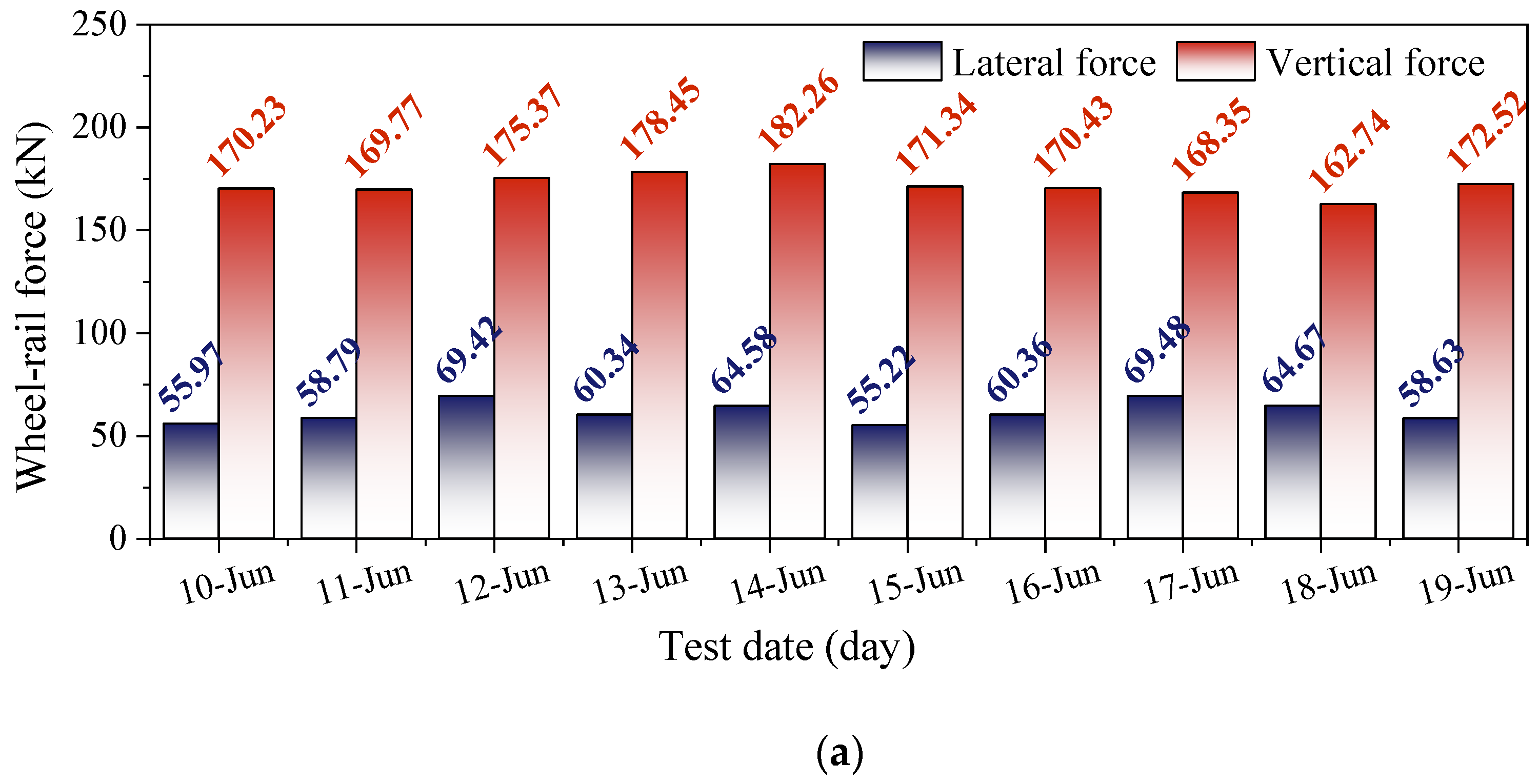
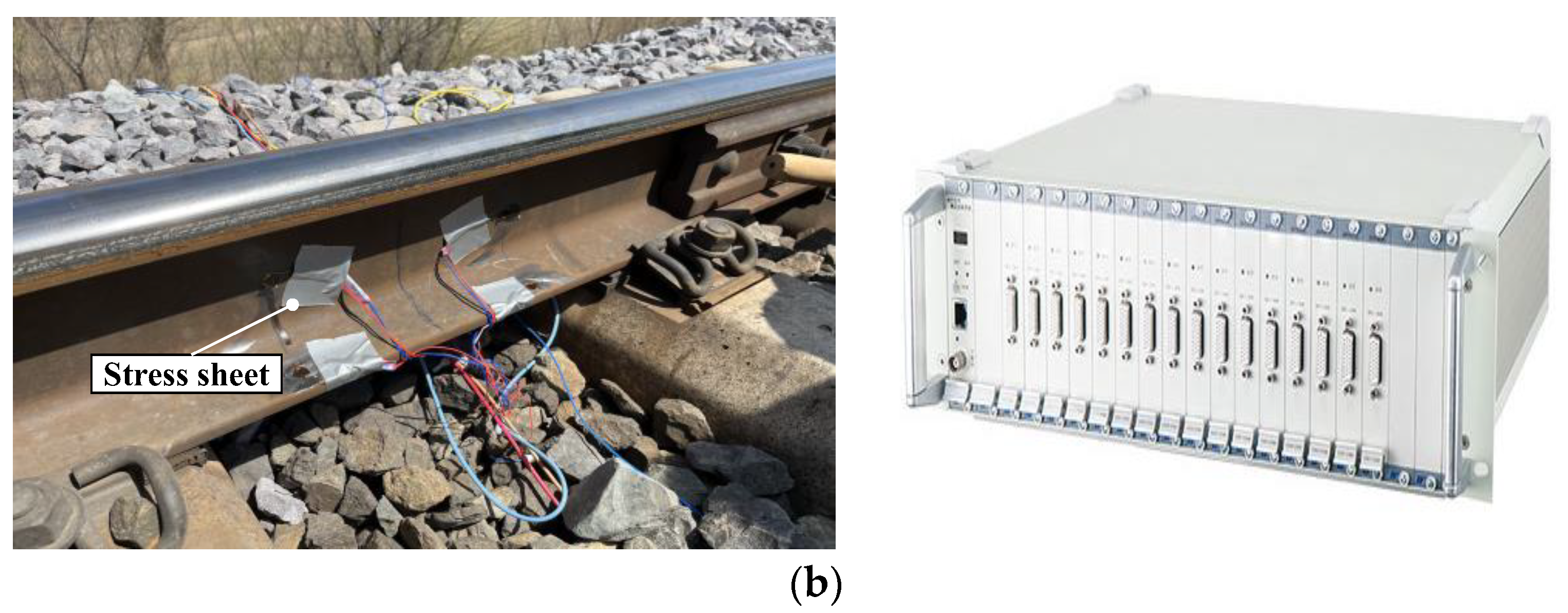
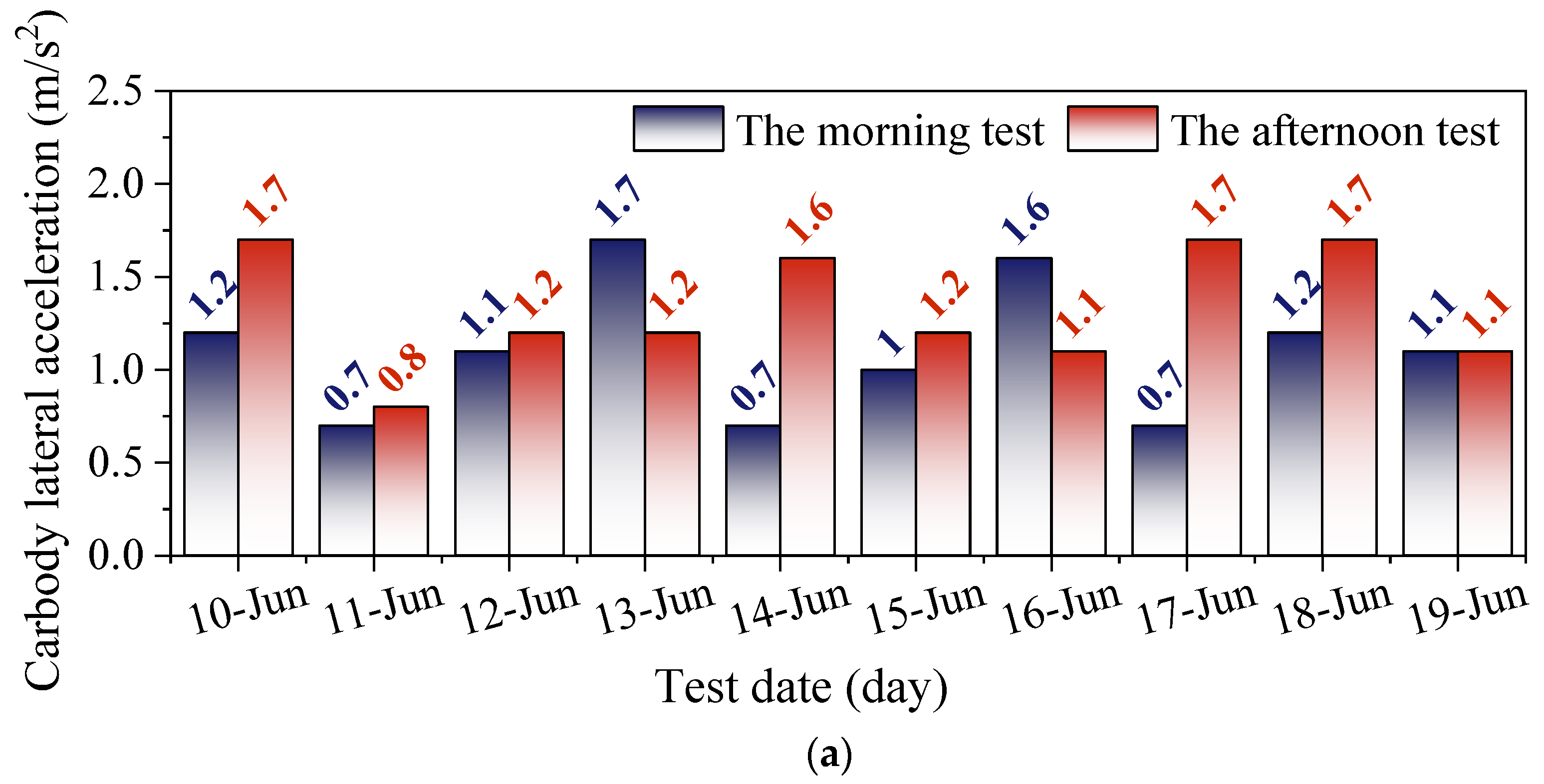
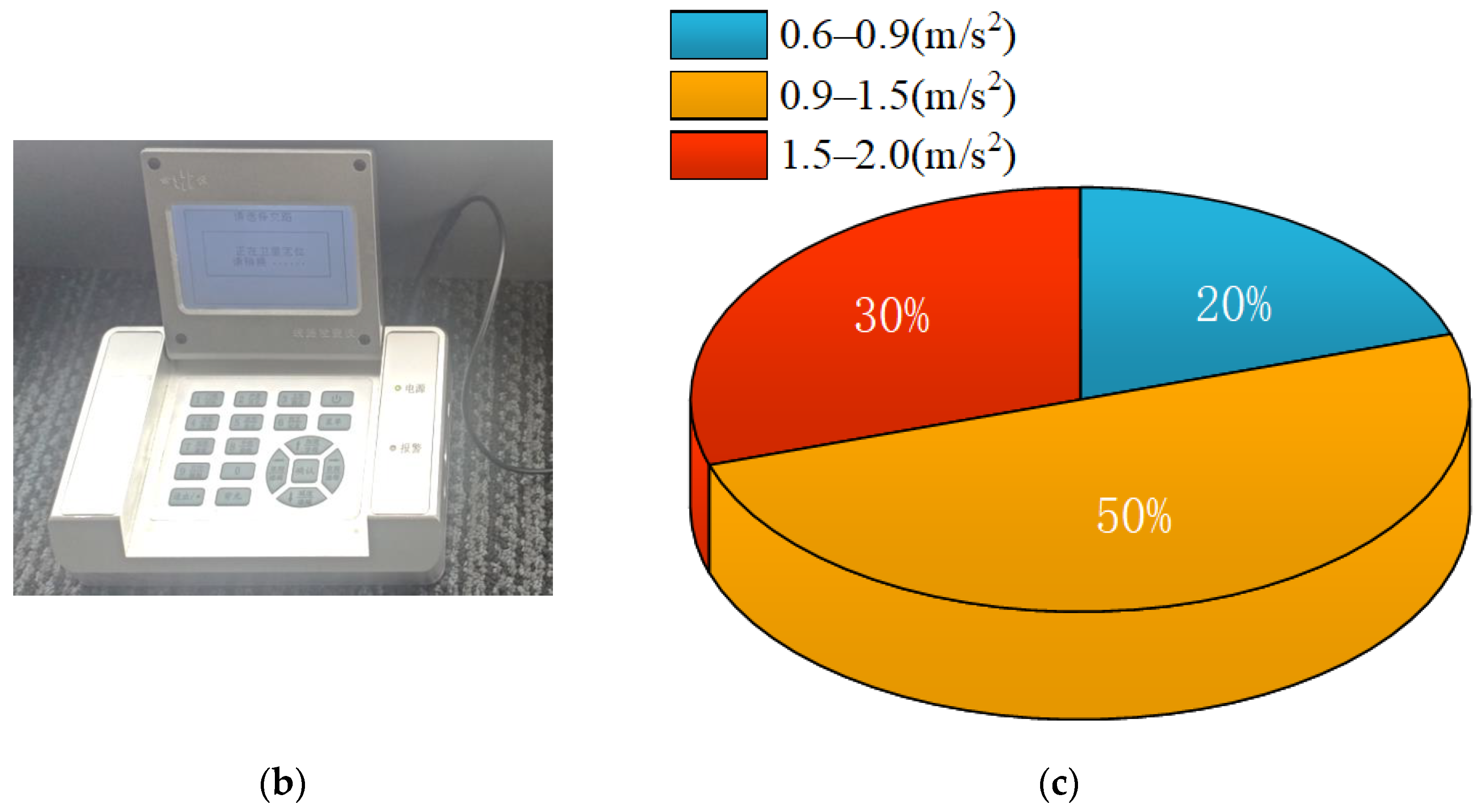
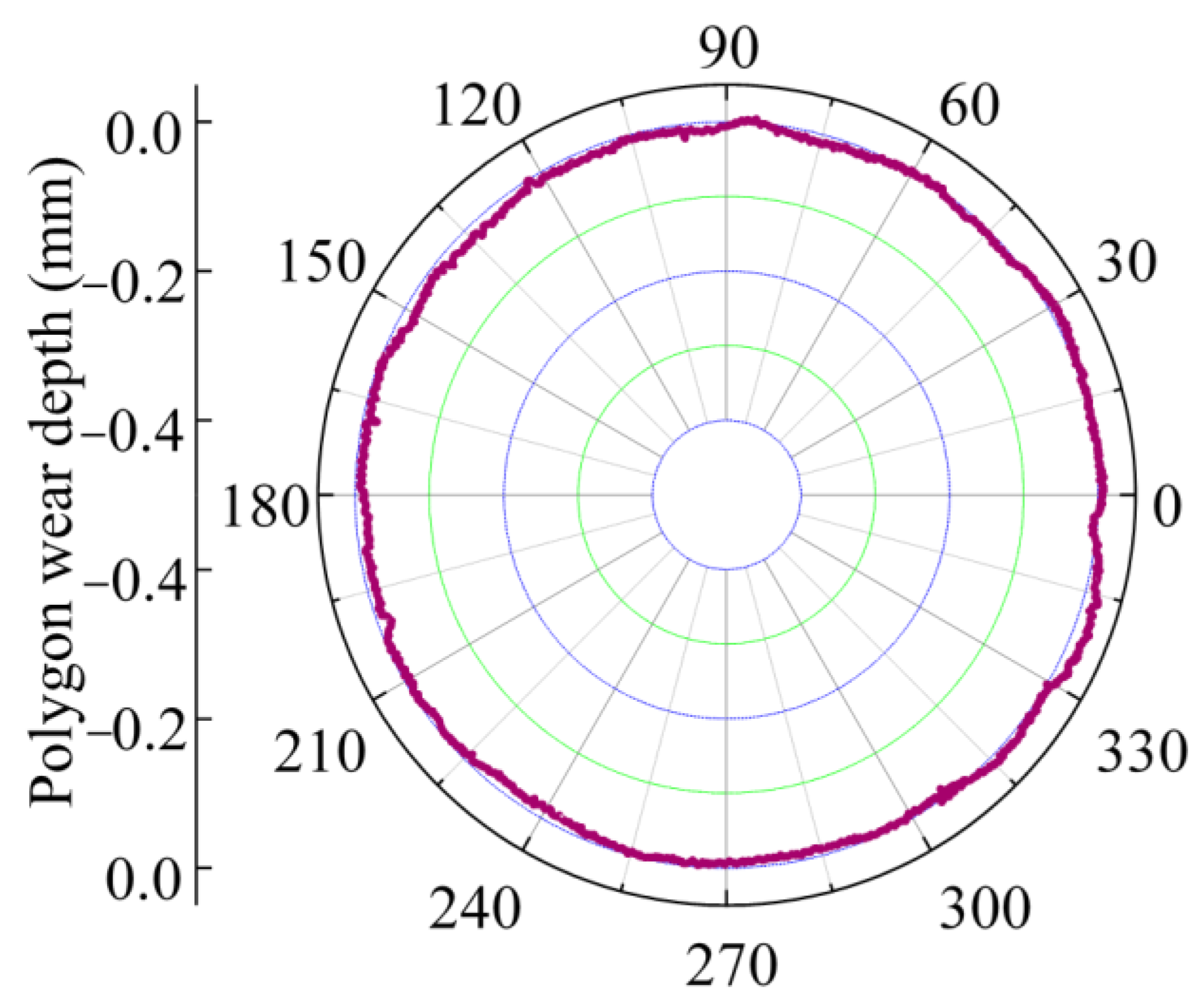
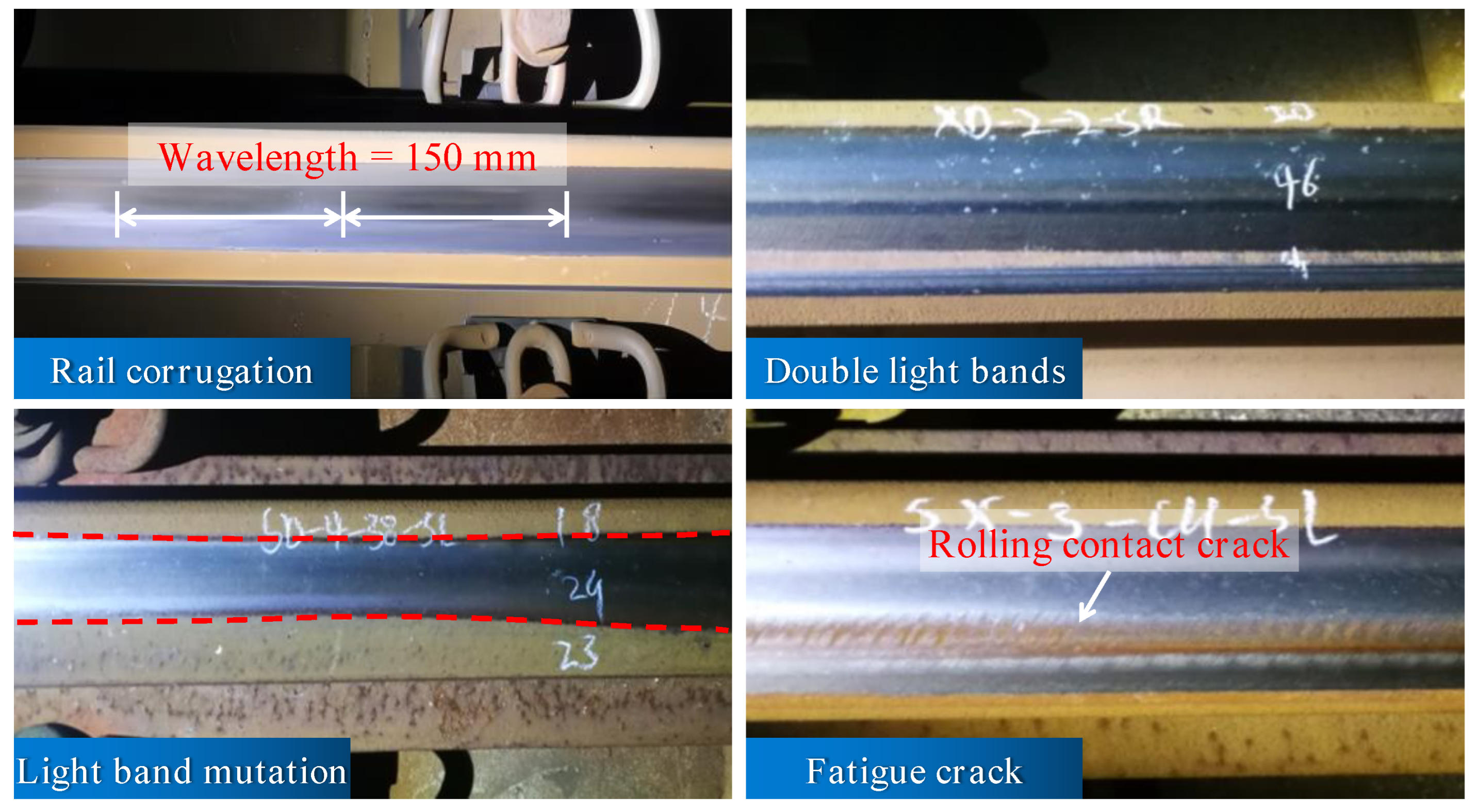
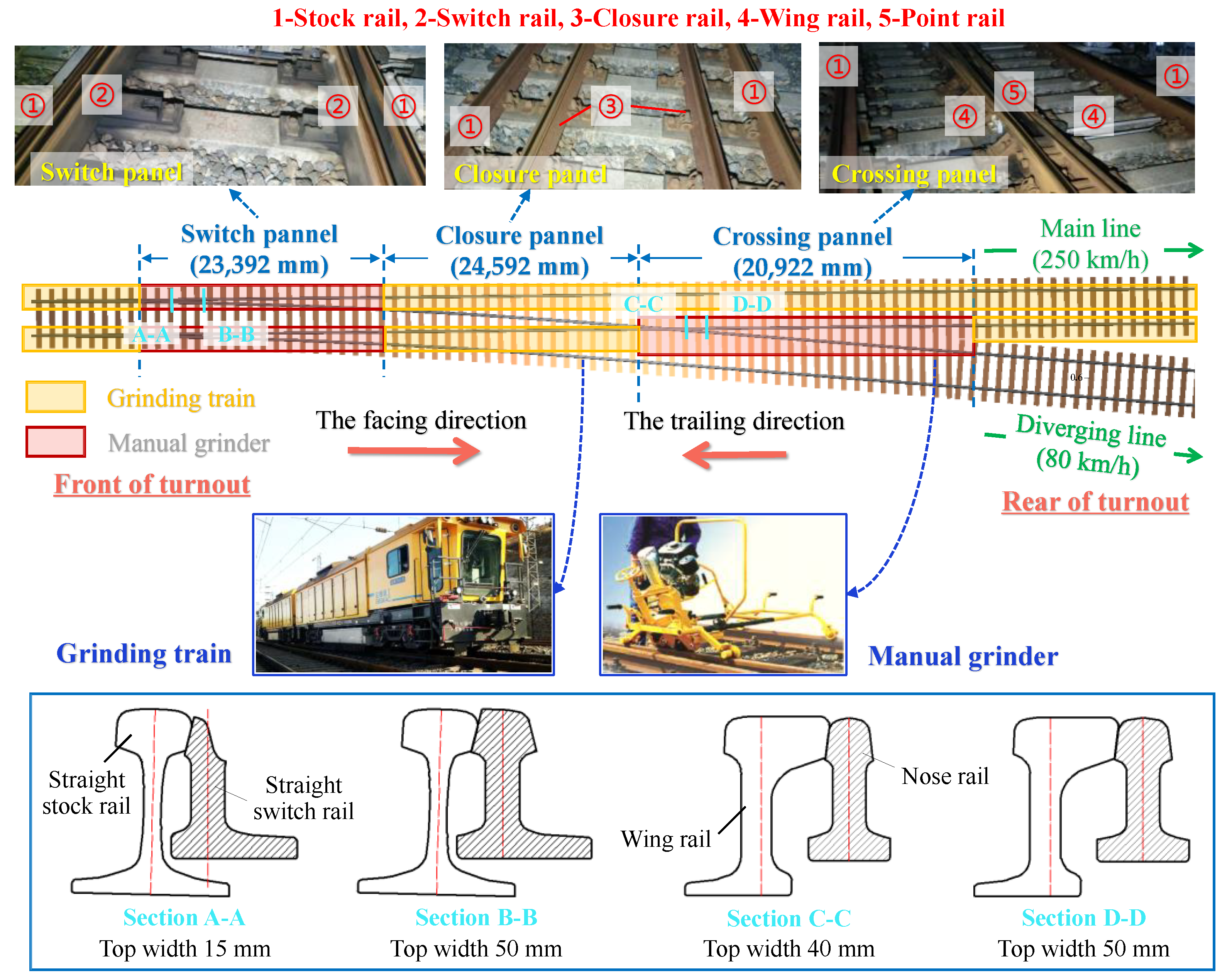
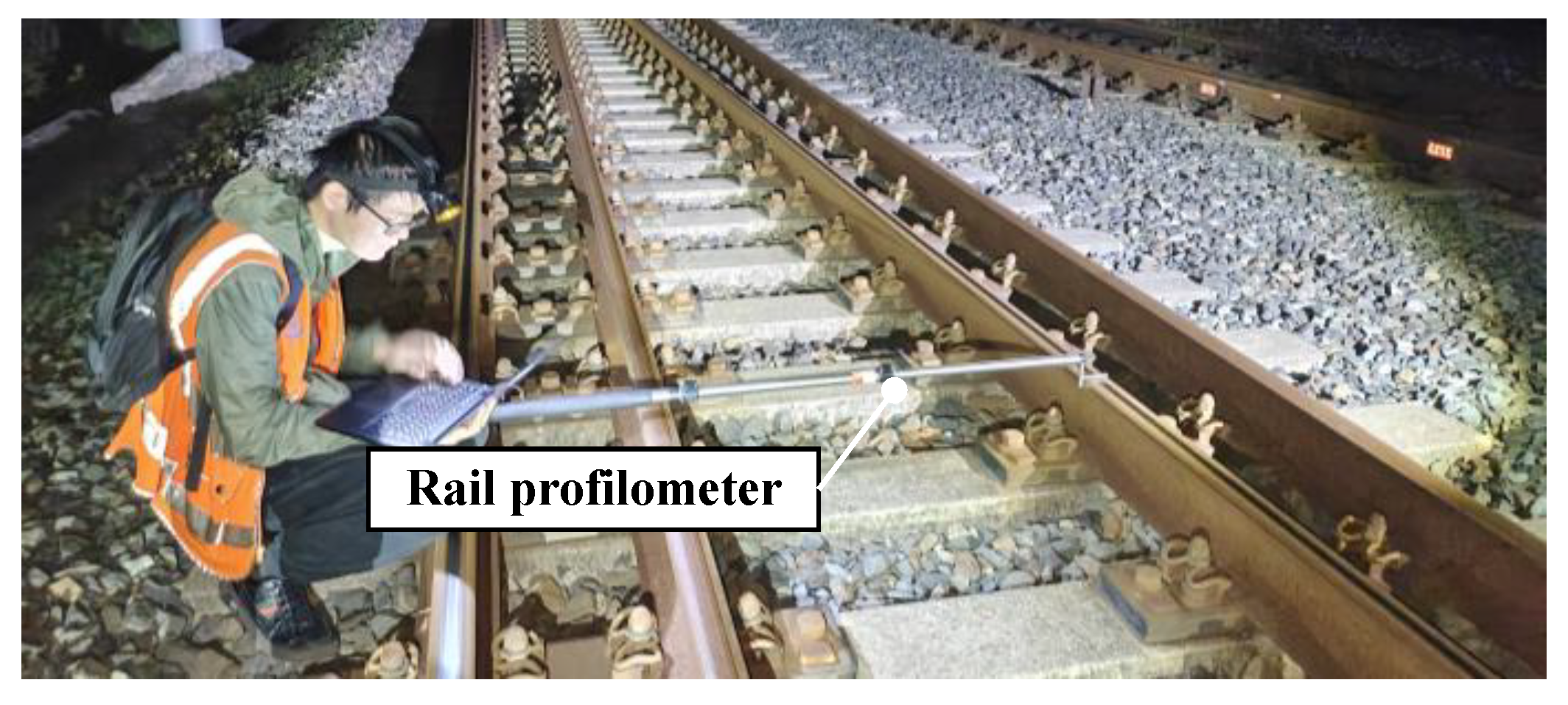
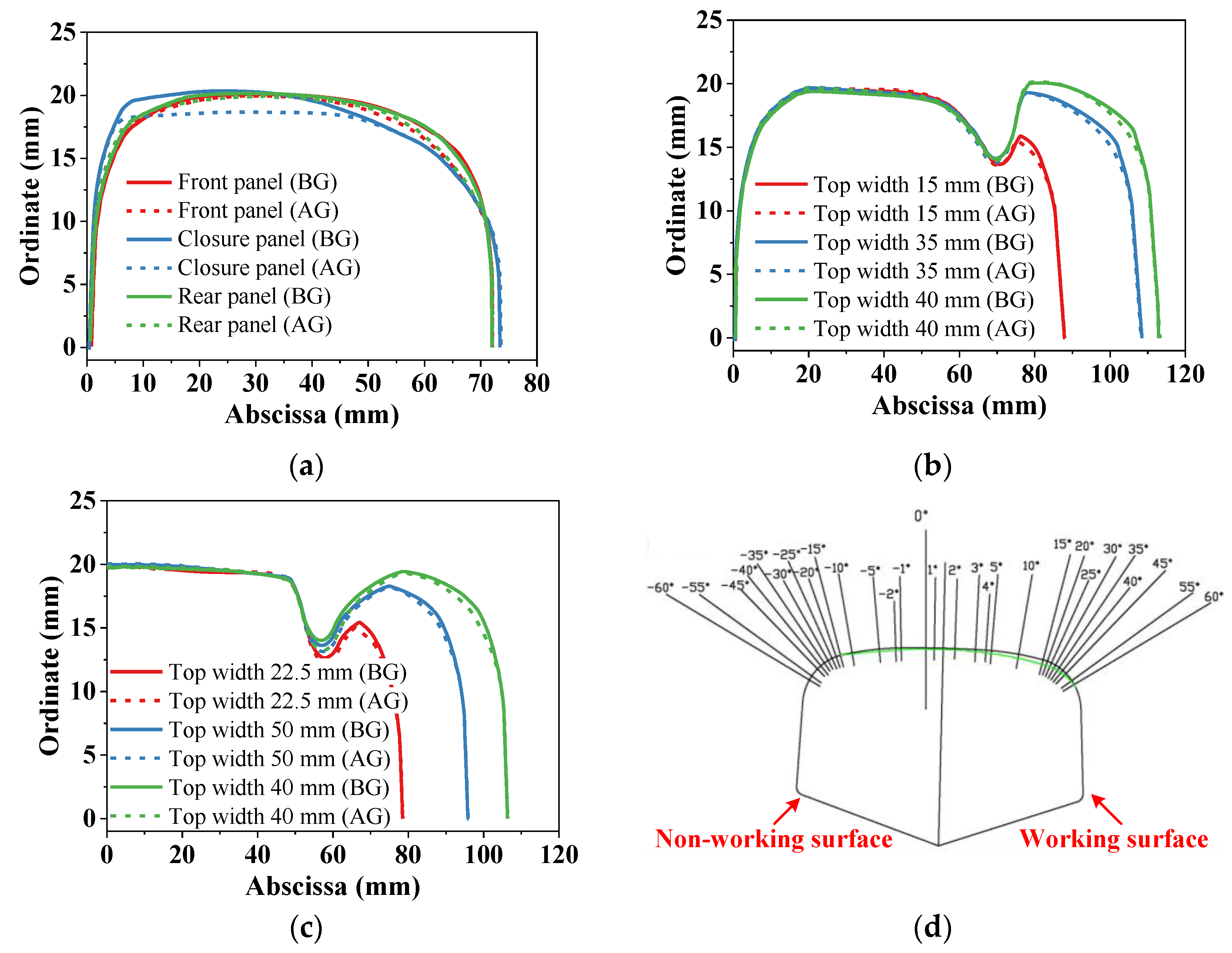




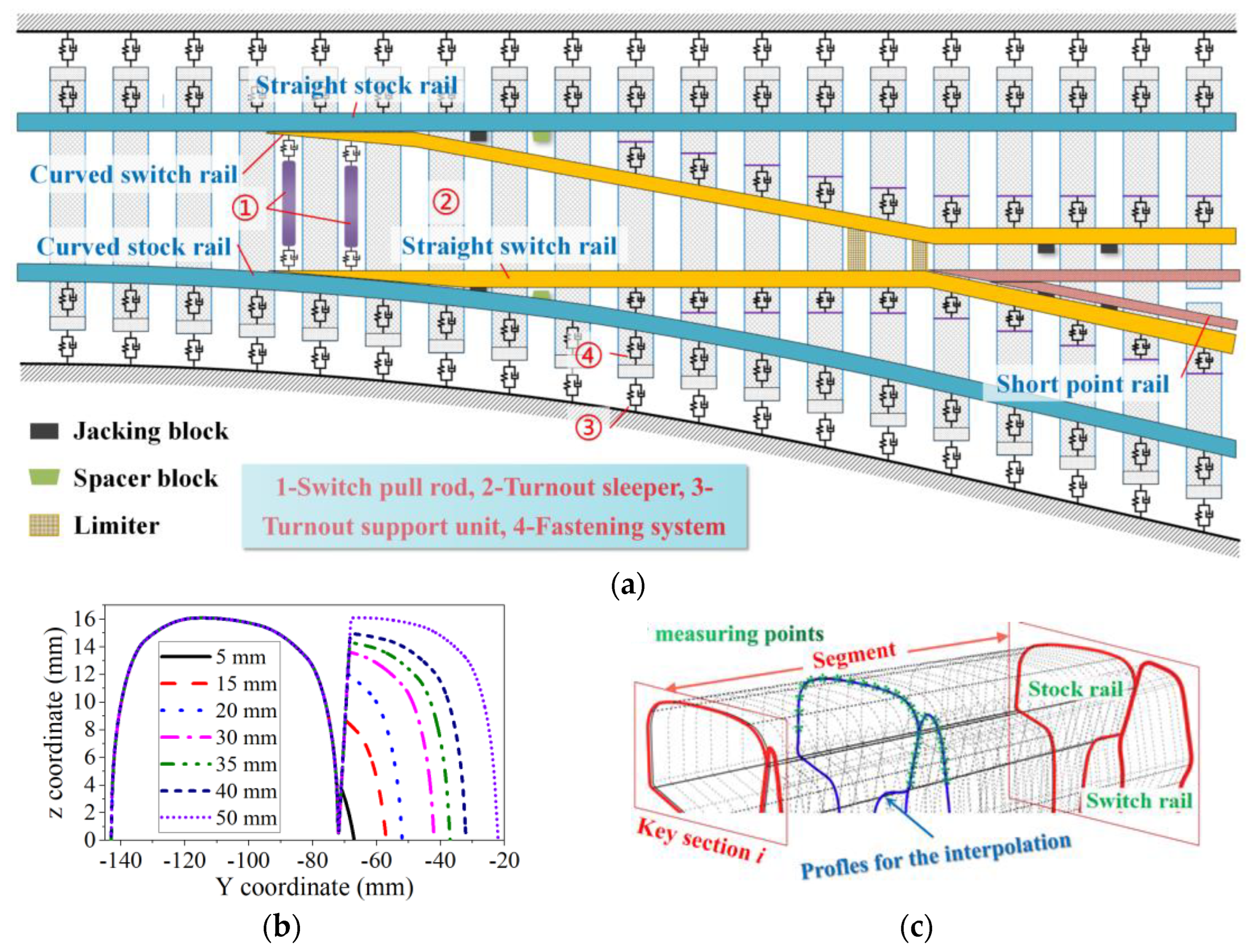
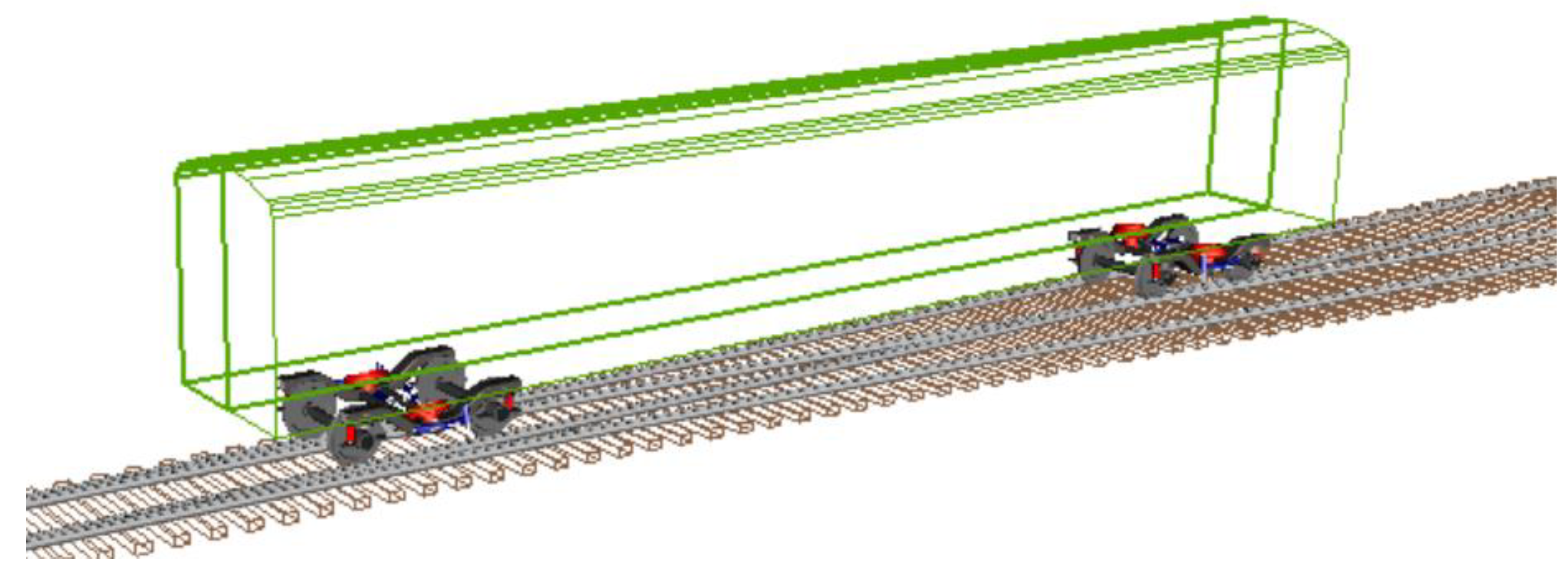
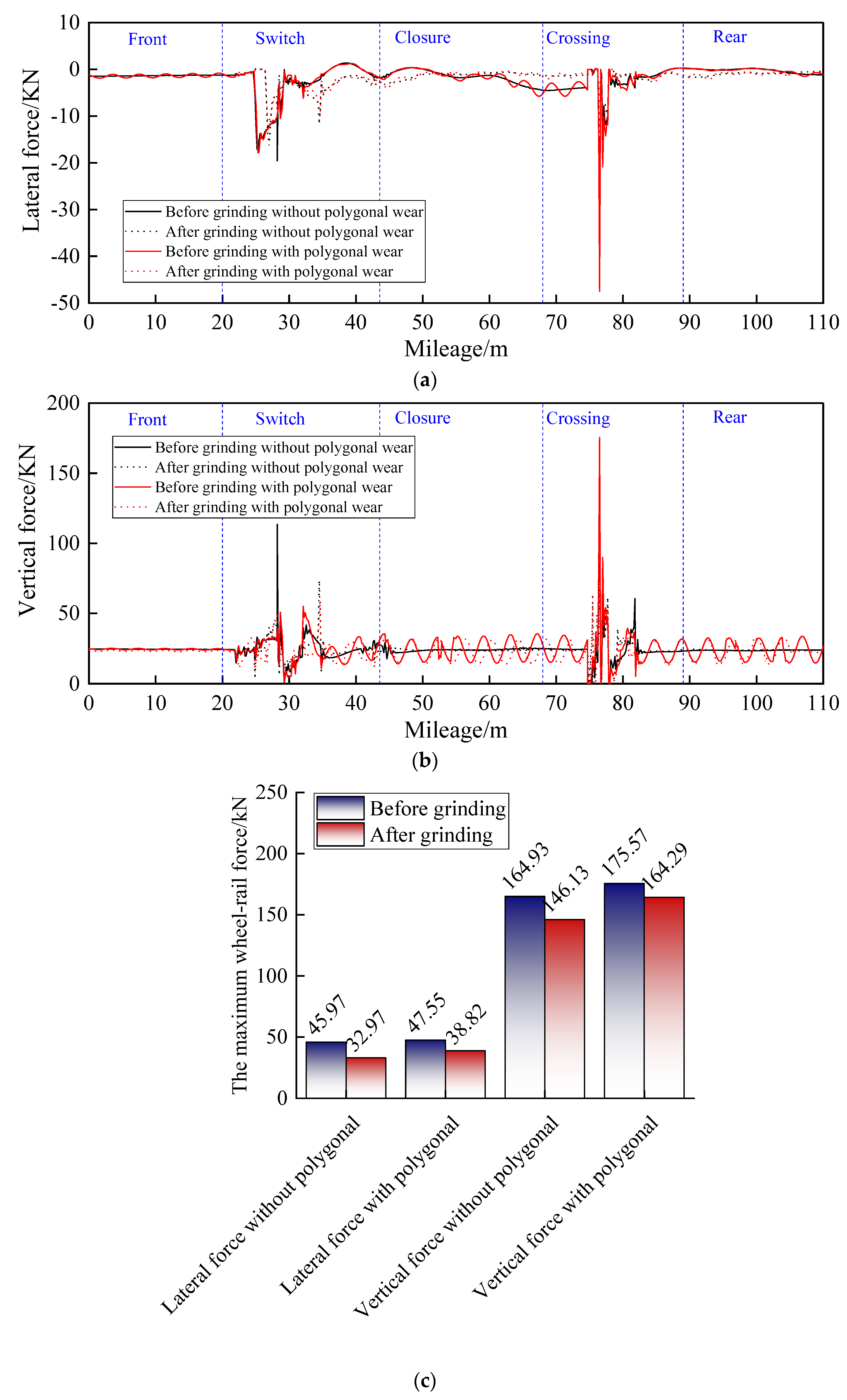
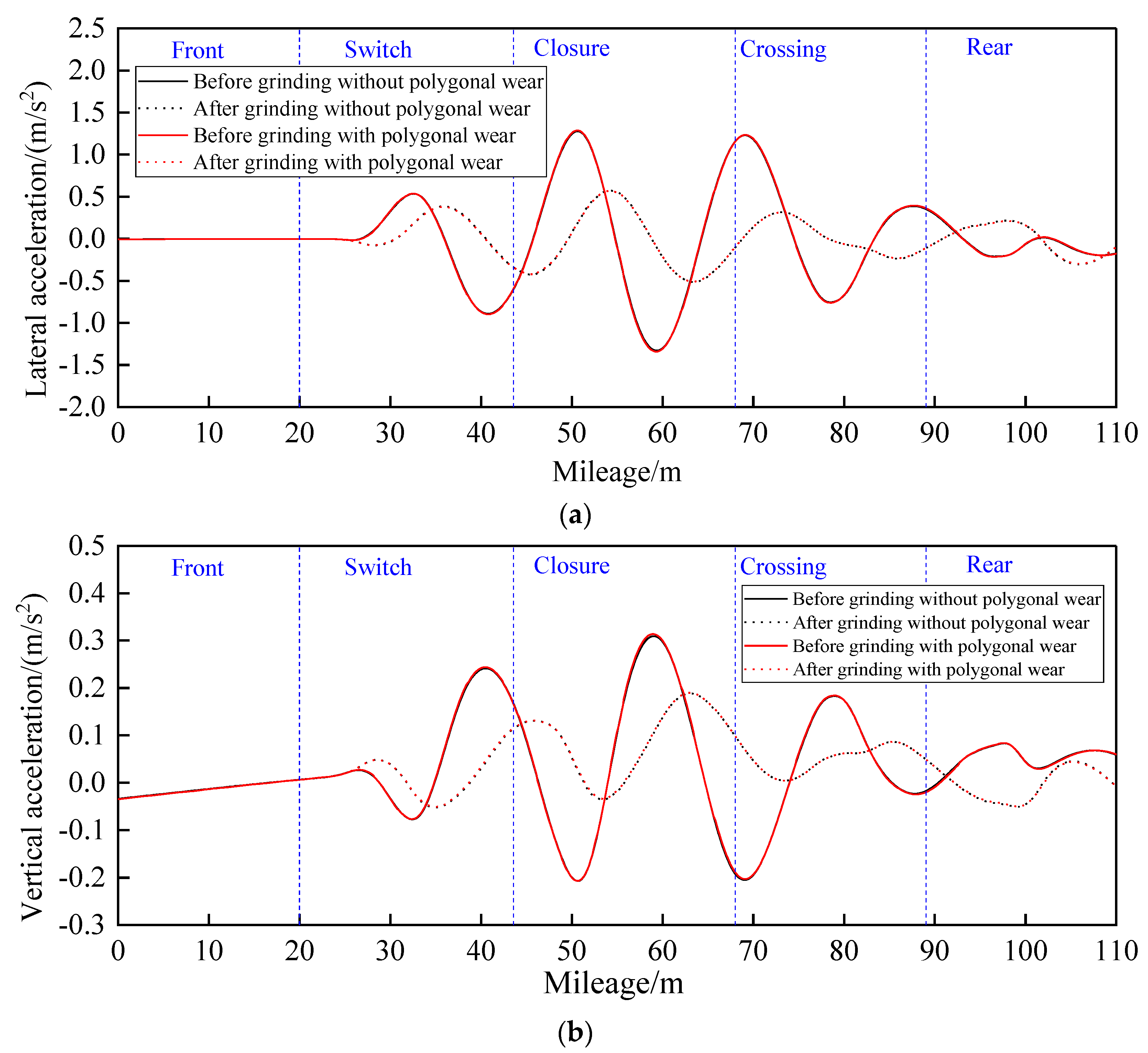

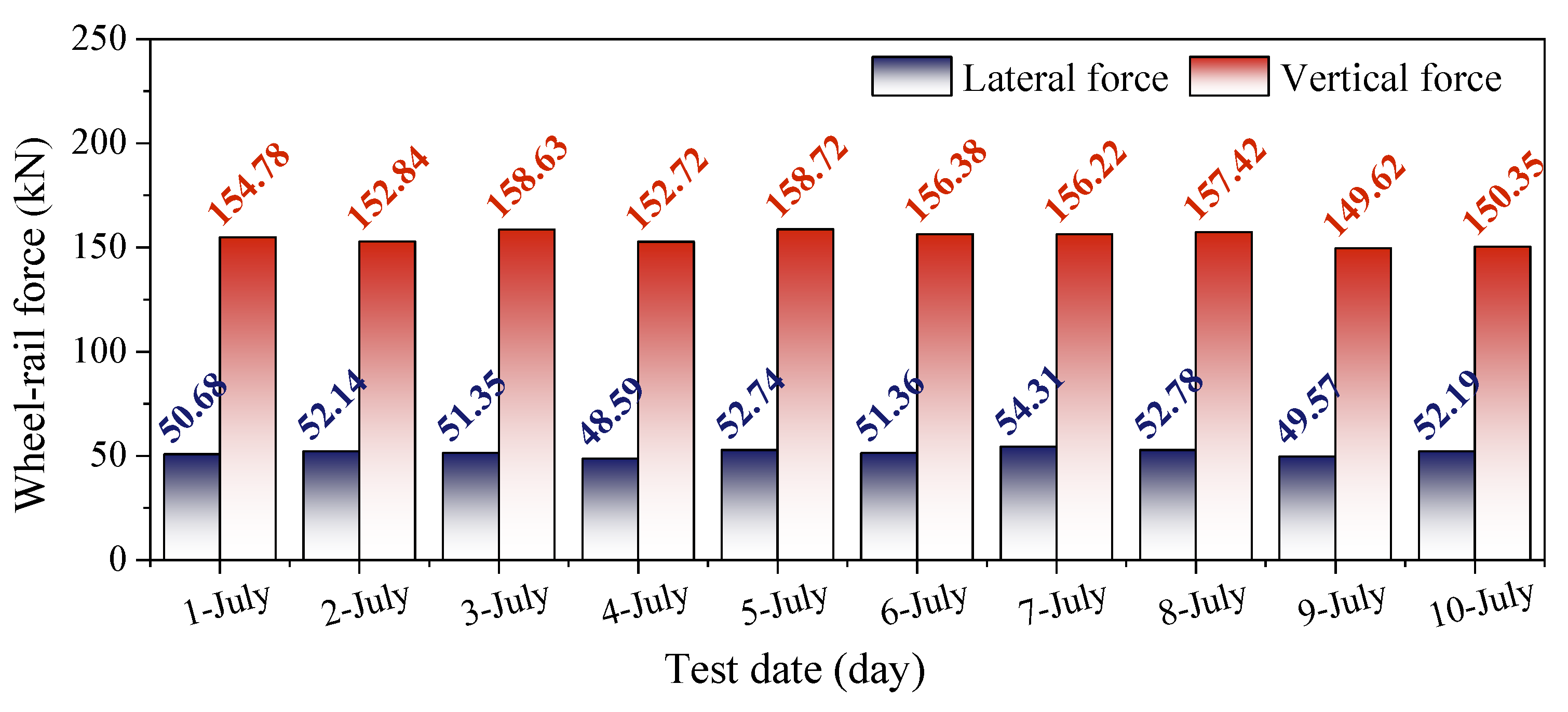

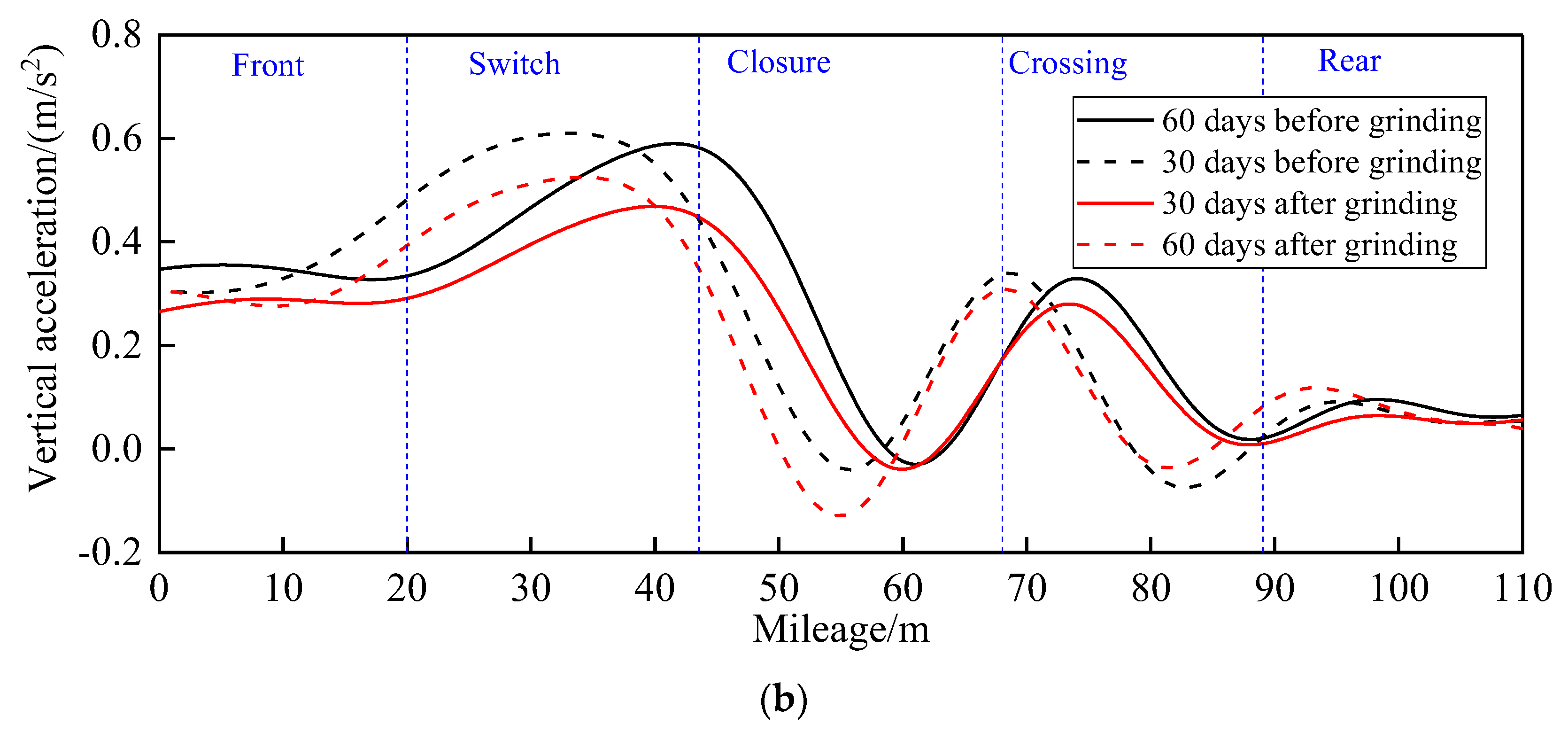
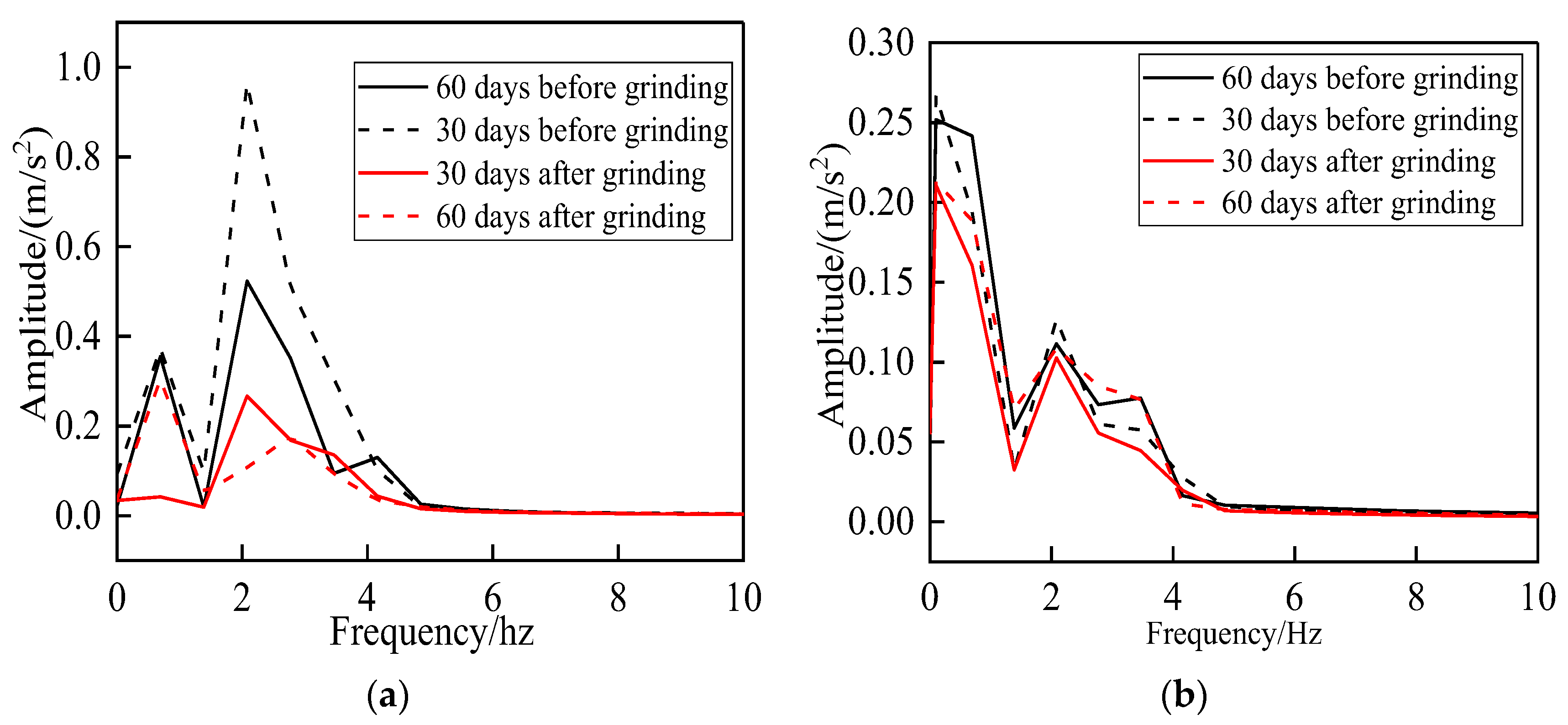
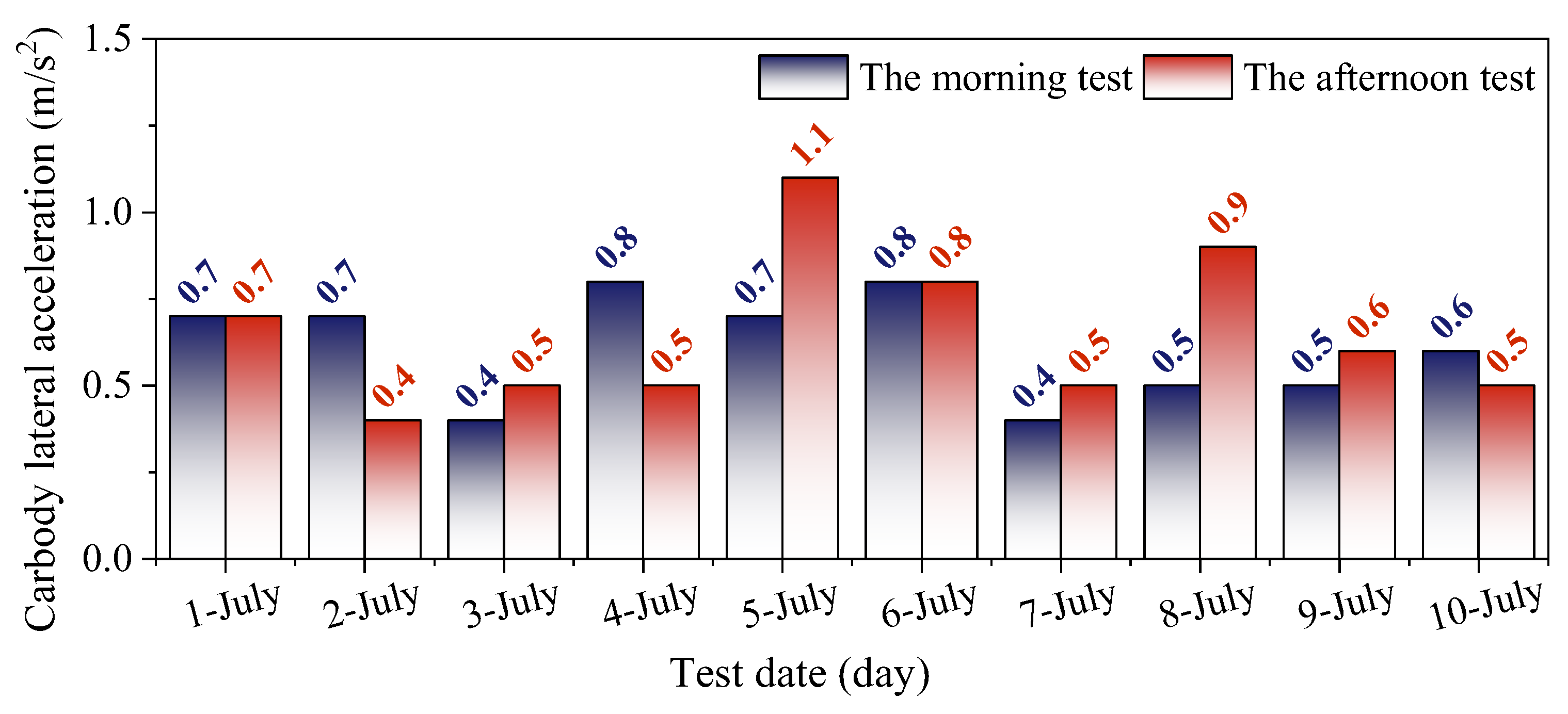
Disclaimer/Publisher’s Note: The statements, opinions and data contained in all publications are solely those of the individual author(s) and contributor(s) and not of MDPI and/or the editor(s). MDPI and/or the editor(s) disclaim responsibility for any injury to people or property resulting from any ideas, methods, instructions or products referred to in the content. |
© 2023 by the authors. Licensee MDPI, Basel, Switzerland. This article is an open access article distributed under the terms and conditions of the Creative Commons Attribution (CC BY) license (https://creativecommons.org/licenses/by/4.0/).
Share and Cite
Xiao, Q.; Yang, Y.; Chang, C.; Li, D. Monitoring and Evaluation of High-Speed Railway Turnout Grinding Effect Based on Field Test and Simulation. Appl. Sci. 2023, 13, 9177. https://doi.org/10.3390/app13169177
Xiao Q, Yang Y, Chang C, Li D. Monitoring and Evaluation of High-Speed Railway Turnout Grinding Effect Based on Field Test and Simulation. Applied Sciences. 2023; 13(16):9177. https://doi.org/10.3390/app13169177
Chicago/Turabian StyleXiao, Qian, Yihang Yang, Chao Chang, and Dongzhe Li. 2023. "Monitoring and Evaluation of High-Speed Railway Turnout Grinding Effect Based on Field Test and Simulation" Applied Sciences 13, no. 16: 9177. https://doi.org/10.3390/app13169177
APA StyleXiao, Q., Yang, Y., Chang, C., & Li, D. (2023). Monitoring and Evaluation of High-Speed Railway Turnout Grinding Effect Based on Field Test and Simulation. Applied Sciences, 13(16), 9177. https://doi.org/10.3390/app13169177





